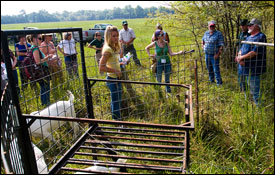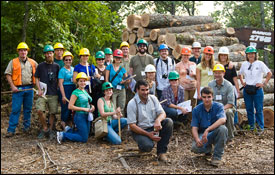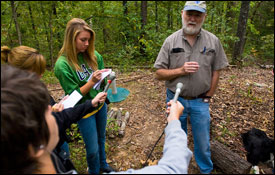Field Trip Teaches Students about Writing for a Non-Science Audience

Columbia, Mo. (Sept. 22, 2009) — Moving from forests, to caves, to prairies and dairy farms, students in Professor Bill Allen’s eight-week “Field Reporting on the Food System and Environment” agricultural journalism course hit the road during the weekend of Sept. 11-13, in a classroom on wheels.
Eleven Missouri School of Journalism students covered more than 1,000 miles aboard a Cavallo bus during the annual Sonja Hillgren/Farm Journal Ag Journalism Field Reporting Institute (FRI) to gain practical reporting experience and learn about the complex connections of issues in agriculture, the environment and natural resources. The group worked to synthesize the information to write for a broad, non-science audience.

“Among other aims, we wanted to expose these students to the challenges of getting away from the phone and Web and into the field for several long days in pursuit of complicated stories,” Allen said. “We went from dawn to almost midnight, hitting the laptops after a late supper to start writing the story while it was still fresh – like the best professionals do.”
The trip is the main focus of Allen’s course, which is designed to teach students about multiple aspects of the environment and food system through hands-on experience and seminar-style discussions. The course offers an opportunity for students to get a closer picture at the science and agricultural subjects about which they are writing, and the students explore the scientific, economic, social, ethical, and political aspects of the environment.

The students traveled widely around southwest Missouri for approximately 62 hours. They were accompanied by eight “traveling faculty,” as Allen calls them. These are scientists, professional journalists and University of Missouri faculty who accompany the students on the bus and in the field. Among the faculty was John Schneller, associate professor and faculty editor of the Columbia Missourian. A gift from Farm Journal supports the trip.
“The FRI gave us a rare opportunity to test our mettle in an intensive setting,” said journalism master’s student Teresa Shipley. “I felt like my brain was being whipped into shape during the three-day experience, but it’s a testament to the nature of the trip that I finished feeling more invigorated and energetic than when I started.”

The first stop on the trip was at the Harry S. Truman Reservoir area near Warsaw, where students learned about feral hogs and the problem they pose to the Missouri ecosystem and landowners. Other highlights of the trip included stops at the Lead Mine Conservation Area forest, the Wah’ Kon-Tah Prairie, the MU Extension Southwest Research Center and the Ozark Underground Laboratory. At these and other locations, the students met with experts from MU and the Missouri Department of Conservation as well as local landowners.

“Learning in the field how to interview a variety of sources, find story ideas and write on a deadline after a long day was a great challenge,” said agricultural journalism junior Kathleen Sprouse. “It made me excited to be a reporter, and it showed me that people want to share their story.” The student stories will be published at Farm Journal Online and potentially in other publications.
The trip is a part of the MU Agricultural Journalism Program in the College of Agriculture, Food and Natural Resources and is conducted each year in cooperation with the Missouri School of Journalism. It is named in honor of Sonja Hillgren, BJ ’70, MA ’72, who died in 2006 of a brain tumor. At the time of her death she served as senior vice president/editorial for Farm Journal Media, the parent company of Farm Journal, the magazine she edited from 1995 to 2004.
Updated: May 5, 2020